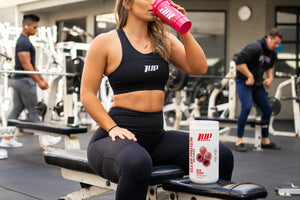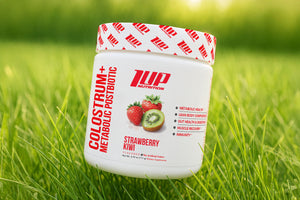Your ability to perform at a high level, and ultimately get stronger and build more muscle, hinges on your ability to recover.
Hard training demands serious recovery. Unfortunately, many individuals tend to focus solely on “crushing it” in the gym, but don’t do their due diligence towards optimizing their rest and recovery.
Little do they realize this lack of sufficient recovery is actually hindering their progress in the gym, and ultimately their results.
Today, we share with you 3 simple recovery methods to train harder (and get better results!) than ever before.
3 Simple Recovery Methods for Better Recovery & Growth
#1 Low-Intensity Active Recovery
For athletes who love training and the routine that goes with living a healthy and fit life, taking an off day from the gym is quite the struggle. Yet, these “off”days are a vital part of allowing your body to recover, gain strength, and build muscle.
At the same time, just because you’re not actively training a given muscle group (or two) doesn’t mean you have to be a complete sloth and simply lounge around all day binging Netflix and munching on bon-bons.
This is where low-intensity active recovery comes in. Active Recovery has been shown in research to be helpful for enhancing muscle recovery and reducing muscle soreness.[1]
Additional studies indicate that active recovery promotes recovery of neuromuscular function and contractile properties of muscle after fatigue.[2] In other words, active recovery (either in between working sets or after your workout) helps your body recover better and restores muscle function and the ability to contract at its peak better than passive recovery or not doing anything at all.
So, what qualifies as “active recovery?”
As the name implies, low-intensity active recovery involves low intensity steady state cardiovascular activities, like walking, stretching, light yoga, etc. It’s not the trendiest or sexiest component of a training program, but it does provide some important benefits for recovery.
For starters, low-intensity physical activity, like walking, increases circulation which helps clear away waste products generated by higher intensity physical activity (resistance training, HIIT, sprinting, etc.) and deliver oxygen and nutrient-rich blood to skeletal muscles, which promotes greater recovery, repair, and growth.
Active recovery sessions also allow the CNS to recharge so that you can attack your next high-intensity training session with gusto and grit needed to create overload. As tempting as it may be to try to push the envelope each and every day of the week, the simple truth of the matter is that the body and mind can only take so much. They need some down time (aka recovery sessions) to recharge fully so that they can then induce overload.
One of our favorite active recovery methods is walking -- it’s easy on the joints, increases circulation, and helps burn calories.
You can do it on training days and non-training days without fear that it will “stunt your gains” as is commonly believed with other steady-state cardio modalities.
Start with 10-20 minutes and increase as your fitness and fatigue management improve. Remember, though, active recovery is supposed to be low-intensity. You’re not trying to end in a full flop sweat, gasping for air.
#2 Compression Garments
Compression garments are a recovery tool top-tier athletes have been using for quite some time, and for good reason -- they’re known to reduce perceptions of fatigue and muscle soreness.
As to how/why compression garments improve recovery, researchers believe that the beneficial effects of compression garments on DOMS and perceived fatigue might be due to reduction in the space available for swelling and edema due to the compression applied to the limb.[1]
Since the muscle is compressed, there is less chance for swelling to occur, which results in smaller changes in osmotic pressure allowing for better venous return of blood (and with it waste metabolites).
It’s commonly thought that compression garments may help reduce exercise-induced muscle damage and inflammation; however, the findings of a 2018 meta-analysis that examined various recovery techniques on markers of muscle damage, soreness and fatigue, did not observe any significant changes in creatine kinase (CK), interleukin-6 (IL-6), or c-reactive protein (CRP) concentrations after the use of compression garments following exercise.[1]
#3 Massage
The final simple recovery method to try if you want to improve recovery and train harder is massage.
In fact, some research indicates that massage may reduce DOMS for 72 hours after exercise![3] Massage is also beneficial for reducing levels of creatine kinase and IL-6 in the blood after exercise. CK and IL-6 are two common metabolic markers used to assess muscle damage following exercise.
The reason for this is that massage increases blood and lymph flow, which reduces the amount of creatine kinase released from damaged tissues and increases the amount creatine kinase clearance from the blood.
Massage may also modulate immune compounds, and researchers believe these compounds may have a direct impact on fatigue and signs of exercise-induced muscle damage.[4]
A 2018 meta-analysis that examined various recovery techniques (including active recovery and compression garments) concluded that:
“Massage seems to be the most effective method for reducing DOMS and perceived fatigue.”[1]
Researchers noted that other recovery techniques, like active recovery, cold water immersion, or compression garments, were helpful, but seemed to have the most effect on measure of perceived fatigue.[1]
Massage can come in many different forms. Really, think of it more as manual manipulation of soft tissues on the body.
You can go to a soft tissue specialist like a masseuse, or simply use your hands, foam roller, or lacrosse ball to work the tight muscles on your body and promote recovery and circulation.
Takeaway
Recovery is an important part of the training process. Without it, your performance, gains, and results will be severely limited.
In addition to the recovery methods outlined above, it’s also important to keep a close eye on your nutrition. Consuming enough protein and total calories each day will have tremendous impacts on your ability to recover. No amount of recovery protocols can make up for adequate nutrition. This is part of the reason it takes longer to recover when you’re dieting -- your body doesn’t have enough raw materials and energy to fuel the recovery processes.
To optimize nutrient intake and support the recovery process, we like to have a fast digesting shake immediately after training containing one scoop of protein powder (such as 1UP Whey protein) and one to two scoops of our fast-digesting carb supplement, Tri-Carb.
This powerhouse combo supplies the body with everything it needs to maximize muscle recovery and growth when it needs it most.
References
- Dupuy O, Douzi W, Theurot D, Bosquet L, Dugué B. An Evidence-Based Approach for Choosing Post-exercise Recovery Techniques to Reduce Markers of Muscle Damage, Soreness, Fatigue, and Inflammation: A Systematic Review With Meta-Analysis. Front Physiol. 2018;9:403. Published 2018 Apr 26. doi:10.3389/fphys.2018.00403
- Akagi, R., Imaizumi, N., Sato, S., Hirata, N., Tanimoto, H., & Hirata, K. (2020). Active recovery has a positive and acute effect on recovery from fatigue induced by repeated maximal voluntary contractions of the plantar flexors. Journal of Electromyography and Kinesiology, 50, 102384. https://doi.org/10.1016/j.jelekin.2019.102384
- Guo J., Li L., Gong Y., Zhu R., Xu J., Zou J., et al. . (2017). Massage alleviates delayed onset muscle soreness after strenuous exercise: a systematic review and meta-analysis. Front Physiol. 8:747. 10.3389/fphys.2017.00747
- Tejero-Fernández V., Membrilla-Mesa M., Galiano-Castillo N., Arroyo-Morales M. (2015). Immunological effects of massage after exercise: a systematic review. Phys. Ther. 16, 187–192. 10.1016/j.ptsp.2014.07.001






